Use DevOps to turn IT into a strategic weapon.
As usual when working on course materials, there are often things that seem to be unnecessary, because it’s understandable, but they are written very well and it’s hard not to share them. So this article is interesting because it once again shows the range of tasks covered in DevOps
Go…
Working together with co-authors on the DevOps Cookbook, I began to understand better what is the main focus of the DevOps community. Much attention is paid to the impact of DevOps within the IT department. Much less attention is paid to the impact of DevOps throughout the company. And virtually no attention is paid to the influence of DevOps outside the company, in particular the relationship with other companies and markets in which they compete.
')
This inward-looking approach is understandable, given that the DevOps movement was laid down by engineers for engineers — breaking down barriers, improving interaction, maintaining quality, fast feedback, automating everything that only the soul desires — messages that speak for themselves.
But if you limit DevOps evangelism to only IT organizations, you will miss the valuable benefits of investing in DevOps. Why? Because the lessons and principles of DevOps open something rare for modern companies. DevOps can turn IT processes into a sustainable competitive advantage for a company. This DevOps message needs to be distributed throughout the company's business department, right up to the CEO and the Board of Directors.
To understand how DevOps can turn IT processes into a competitive advantage, you first need to look at the current context in which companies operate.
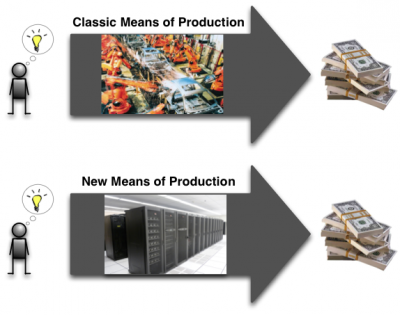
Now customers communicate with you using standard interfaces (browser or mobile application), which are connected via standard protocol (http).

Thus, from the point of view of deals with a potential buyer, your business is on a par with other competitors.
The last loud battles in the product world have clearly shown that any idea worthy of copying can and will be copied. Of course, copying ideas is a well-known phenomenon in business. However, a separate side effect of the modern online world is the ever increasing speed with which online ideas can be copied. Having a “good idea” just doesn't give a big handicap. The barriers are so low that some people base business models on this idea (and I am sure they will soon see how others start to imitate them).

As part of the discussion, we will reject branding (“Enjoy Coca-Cola”) and business model strategies (from viral effects to bundles). All of them are not the focus of this blog, and their long-term impact on online business needs to be discounted due to the effects of business reality # 2 described above.
What are the potential areas of competition left?
In my opinion, the choice is already obvious, but take a look at each item separately.
1. Scale
Scalability, although necessary, is not an area in which a strategic competitive advantage can be obtained. Scaling online services is, in essence, a solved problem. With enough money and smart guys (yes, to find such a special art) will be able to scale almost anything. And if you can do it, it means your competitors too. Delete from the list.
2. Lowest prices
Becoming a supplier of low prices is very tempting in terms of receiving individual sales transactions. But, having looked wider at the consequences, such a life begins to seem much more difficult.
First, there can only be one “lowest price” provider. This automatically raises the stakes to the “winner takes all” scenario. Secondly, by betting on the lowest price, you unwittingly become a racer on the bottom, especially in the digital market, where the marginal cost of a product or service can be very low. You cannot control how much competitors will lower prices, and in the end there is nothing cheaper than “free”. Low prices may be part of your overall business strategy, but they are limited by the ability to provide long-term competitive differentiation. Delete from the list.
3. Continuous Innovation
Continuous innovation remains. Unfortunately, “continuous innovation” seems the most difficult option, is not it? Consider “innovations” first - do you really have everything you need to outrun your competitors, occupy a niche and satisfy customers? And the “continuity” factor - do you really have everything to do it all the time?
Despite the complexity, this is the only remaining option. Therefore, we will begin to look for an answer to the question of how to turn this into a core competency.
But, regardless of which option you prefer, there is a basic set of actions that support innovation. In the context of online business, the business idea and its transformation into a functional that provides feedback to the business in a customer-oriented environment are taken as the basic unit of innovation activity.
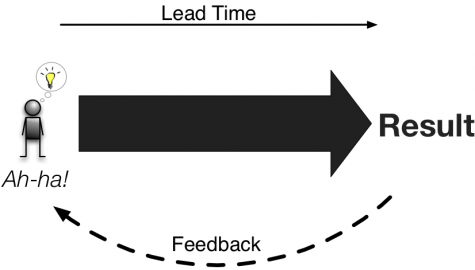
An innovation-based competition comes down to this unit or life cycle. If you manage to achieve a successful result faster and more reliably than your competitors, then this is enough to achieve a competitive advantage.
Of course, everyone wants to believe that the result obtained at the end of each innovation cycle is an unconditional success. But in reality, not everything is so sweet. We look forward to praising customers and a mountain of money, but this rarely happens.
How bad is it? The Doblin Group conducted global research and found that only 4% of all innovation activity meets or exceeds investment return targets. Booz Allen found “no significant statistical correlation between R & D expenditures and the main metrics of financial or corporate success.” Even about such “innovative factories” as portfolios of venture capital, you can hear the numbers : 80% of companies come out either with minimal profitability for investors, or they completely fail.
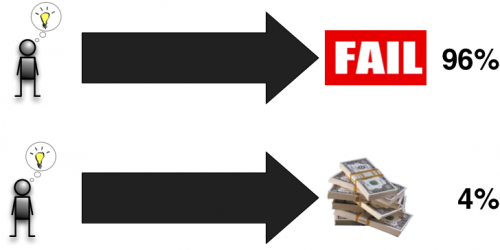
Therefore, despite our persistent desire to think differently, the vast majority of the things that we are trying to accomplish simply do not work. From a macro point of view, innovation is a game with numbers, and numbers work against us.
To earn an advantage, you need to change the numbers in your favor.
It is quite easy to be under the spell of heroic myths about innovation. Everything is invested in them for the sake of describing one impressive attempt at success. When recreating the story, an “impressive attempt” always seems unconditional, especially for imitation heroes. But in reality, “impressive attempt” is a high-stakes gamble that rarely pays for itself.
Trivial wisdom about how to succeed in innovation, usually says something from the category of "think stronger and better." Hire smart people. Hold a lot of meetings. Get a lot of information. Keep your ideas from prying eyes and mess with them as long as a big premiere is being prepared for the market.
But even if you manage to hire the smartest people in the industry and always work only with perfect timely information, the “think harder and better” approach still draws you into the game with high stakes against you.
And instead of betting on knowingly losing values, there is a better, albeit not so charming, way to win in this game of numbers. Give yourself a chance to find a better niche market than your competitors. Using the sporting metaphor, apply as many “hits on the target” as you can until time runs out.
Keep in mind that these should not be blind strokes. With each attempt you will learn something new and move forward faster to deliver a new blow. In the end, you will change the odds in your favor and (hopefully) come to success before the chance in the market is lost (or in the case of a startup, before the money runs out).
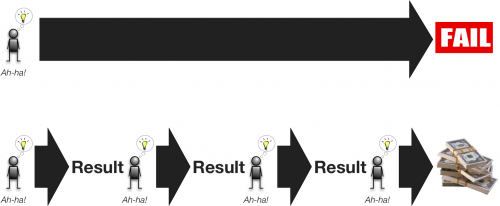
In the example above, we see Company A, which uses the classic strategy with high stakes, and Company B, which uses the strategy of “strikes against the target”. Company B was able to move safely in its life cycle 4 times faster than Company A. This gives Company B a distinct advantage. Assuming the equality of all other things (the same people, the same amount of money, etc.), this means that the success rate of Company B is 4 times higher. It is enough to increase the number to 8, 16, 32 to see how this turns into a significant advantage.
Competitive advantage through continuous innovation has already become a well-established idea in the business community. The Lean Startup movement is built on this concept, adding eloquence to the case.
And here DevOps appears.
At the most basic level, the main essence of DevOps is to go beyond the old constraints, eliminating bottlenecks and risks that spoil the life cycle of the software development process for Operations. The goal is to introduce a fast and reliable process of turning specifications into implemented functions for the user.
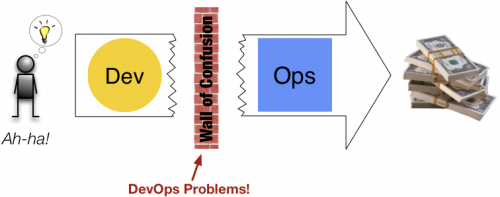
Not coincidentally, the illustration of the software development life cycle looks like the life cycle of innovation described earlier. Using DevOps ideas to eliminate bottlenecks, inefficiencies, and risks in the software development life cycle, you directly improve the speed and quality of the innovation life cycle.
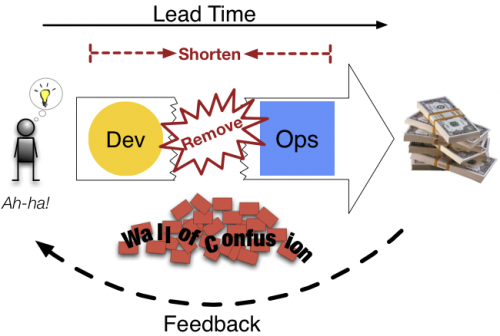
If the goal of your business is to find a competitive advantage through continuous innovation, the goal of IT should be to provide the business with a fast and high-quality development life cycle that allows this innovative advantage to be used. How to understand that he is fast enough? When the development cycle is no longer a measure to limit the speed of a company's development.
The goal should be to get to the point where you can tell the client about your business: “Once you explain the desired task and the developers implement it, all changes will be delivered to the client environment, providing you with feedback. And we can do it faster and more securely than your current service provider. ”

When you reach this point of operational capability, you successfully turn your IT processes into strategic weapons, which gives your company a sustainable competitive advantage.
One final note ... Ignore this call to action at your own risk. Like all competitive advantages, as soon as it is recognized in the market, you can use it against your competitors, or use it against you.
As always, we are waiting for your opinions in the comments or on our Open House . Thank.
Go…
Working together with co-authors on the DevOps Cookbook, I began to understand better what is the main focus of the DevOps community. Much attention is paid to the impact of DevOps within the IT department. Much less attention is paid to the impact of DevOps throughout the company. And virtually no attention is paid to the influence of DevOps outside the company, in particular the relationship with other companies and markets in which they compete.
')
This inward-looking approach is understandable, given that the DevOps movement was laid down by engineers for engineers — breaking down barriers, improving interaction, maintaining quality, fast feedback, automating everything that only the soul desires — messages that speak for themselves.
But if you limit DevOps evangelism to only IT organizations, you will miss the valuable benefits of investing in DevOps. Why? Because the lessons and principles of DevOps open something rare for modern companies. DevOps can turn IT processes into a sustainable competitive advantage for a company. This DevOps message needs to be distributed throughout the company's business department, right up to the CEO and the Board of Directors.
To understand how DevOps can turn IT processes into a competitive advantage, you first need to look at the current context in which companies operate.
Business Realities # 1: Technology alone is not able to provide a competitive advantage
“The potential of technology as a differentiation factor, that is, its strategic potential, inevitably diminishes as technology becomes more and more accessible”The idea that technology is becoming a less competitive differentiator is not at all new. The very nature of the big shift towards online business has only accelerated the reduction of potential for differentiation.
Nicholas G. Carr, the book “Why IT is not a competitive advantage”

Now customers communicate with you using standard interfaces (browser or mobile application), which are connected via standard protocol (http).

Thus, from the point of view of deals with a potential buyer, your business is on a par with other competitors.
Business Realities # 2: Good ideas can (and will) be replicated quickly
The last loud battles in the product world have clearly shown that any idea worthy of copying can and will be copied. Of course, copying ideas is a well-known phenomenon in business. However, a separate side effect of the modern online world is the ever increasing speed with which online ideas can be copied. Having a “good idea” just doesn't give a big handicap. The barriers are so low that some people base business models on this idea (and I am sure they will soon see how others start to imitate them).

So where do you find a competitive advantage?
As part of the discussion, we will reject branding (“Enjoy Coca-Cola”) and business model strategies (from viral effects to bundles). All of them are not the focus of this blog, and their long-term impact on online business needs to be discounted due to the effects of business reality # 2 described above.
What are the potential areas of competition left?
- Scale - removal of restrictions in business from data, users, transactions, etc.
- Lowest prices - customers see you as the most affordable option on the market
- Continuous innovation - continuous search for new ways to meet customer needs and improve the product for the market
In my opinion, the choice is already obvious, but take a look at each item separately.
1. Scale
Scalability, although necessary, is not an area in which a strategic competitive advantage can be obtained. Scaling online services is, in essence, a solved problem. With enough money and smart guys (yes, to find such a special art) will be able to scale almost anything. And if you can do it, it means your competitors too. Delete from the list.
2. Lowest prices
Becoming a supplier of low prices is very tempting in terms of receiving individual sales transactions. But, having looked wider at the consequences, such a life begins to seem much more difficult.
First, there can only be one “lowest price” provider. This automatically raises the stakes to the “winner takes all” scenario. Secondly, by betting on the lowest price, you unwittingly become a racer on the bottom, especially in the digital market, where the marginal cost of a product or service can be very low. You cannot control how much competitors will lower prices, and in the end there is nothing cheaper than “free”. Low prices may be part of your overall business strategy, but they are limited by the ability to provide long-term competitive differentiation. Delete from the list.
3. Continuous Innovation
Continuous innovation remains. Unfortunately, “continuous innovation” seems the most difficult option, is not it? Consider “innovations” first - do you really have everything you need to outrun your competitors, occupy a niche and satisfy customers? And the “continuity” factor - do you really have everything to do it all the time?
Despite the complexity, this is the only remaining option. Therefore, we will begin to look for an answer to the question of how to turn this into a core competency.
What is innovation?
“Innovation is a special tool for entrepreneurship. Something that enhances the potential of enriching existing resources. ”There are many interpretations of what innovation is and is not. The successful implementation of any new idea, some already consider innovation. Some believe that it should be subversive. Some combine innovation and discovery, and some see clear differences between the idea (discovery) and innovation (application).
Peter Drucker
But, regardless of which option you prefer, there is a basic set of actions that support innovation. In the context of online business, the business idea and its transformation into a functional that provides feedback to the business in a customer-oriented environment are taken as the basic unit of innovation activity.

An innovation-based competition comes down to this unit or life cycle. If you manage to achieve a successful result faster and more reliably than your competitors, then this is enough to achieve a competitive advantage.
Innovation is truly a game of numbers.
Of course, everyone wants to believe that the result obtained at the end of each innovation cycle is an unconditional success. But in reality, not everything is so sweet. We look forward to praising customers and a mountain of money, but this rarely happens.
How bad is it? The Doblin Group conducted global research and found that only 4% of all innovation activity meets or exceeds investment return targets. Booz Allen found “no significant statistical correlation between R & D expenditures and the main metrics of financial or corporate success.” Even about such “innovative factories” as portfolios of venture capital, you can hear the numbers : 80% of companies come out either with minimal profitability for investors, or they completely fail.

Therefore, despite our persistent desire to think differently, the vast majority of the things that we are trying to accomplish simply do not work. From a macro point of view, innovation is a game with numbers, and numbers work against us.
To earn an advantage, you need to change the numbers in your favor.
It is quite easy to be under the spell of heroic myths about innovation. Everything is invested in them for the sake of describing one impressive attempt at success. When recreating the story, an “impressive attempt” always seems unconditional, especially for imitation heroes. But in reality, “impressive attempt” is a high-stakes gamble that rarely pays for itself.
Trivial wisdom about how to succeed in innovation, usually says something from the category of "think stronger and better." Hire smart people. Hold a lot of meetings. Get a lot of information. Keep your ideas from prying eyes and mess with them as long as a big premiere is being prepared for the market.
But even if you manage to hire the smartest people in the industry and always work only with perfect timely information, the “think harder and better” approach still draws you into the game with high stakes against you.
And instead of betting on knowingly losing values, there is a better, albeit not so charming, way to win in this game of numbers. Give yourself a chance to find a better niche market than your competitors. Using the sporting metaphor, apply as many “hits on the target” as you can until time runs out.
Keep in mind that these should not be blind strokes. With each attempt you will learn something new and move forward faster to deliver a new blow. In the end, you will change the odds in your favor and (hopefully) come to success before the chance in the market is lost (or in the case of a startup, before the money runs out).

In the example above, we see Company A, which uses the classic strategy with high stakes, and Company B, which uses the strategy of “strikes against the target”. Company B was able to move safely in its life cycle 4 times faster than Company A. This gives Company B a distinct advantage. Assuming the equality of all other things (the same people, the same amount of money, etc.), this means that the success rate of Company B is 4 times higher. It is enough to increase the number to 8, 16, 32 to see how this turns into a significant advantage.
The business community already recognizes this opportunity.
Competitive advantage through continuous innovation has already become a well-established idea in the business community. The Lean Startup movement is built on this concept, adding eloquence to the case.
“Companies holding leadership in the market have less and less time to apply their innovations, and this forces even the most sustainable companies to invest in innovations. I believe that the only way for the company to long-term economic growth is to create an “innovative factory” that uses Lean Startup methods to continuously create disruptive innovations. ”But not only niche Lean Startup adopted this idea. She finds a response in a wide variety of business areas.
Eric Reis
Lean startup
“The world is changing very quickly. It becomes difficult for big business to push small. Now the fast win the slow. ”
Rupert Murdoch
Chairman, News Corp
“The organization's ability to learn and quickly translate this training into action is a critical competitive advantage.”
Jack Welch
Former General Manager, General Electric
“We are already at a stage when almost all top managers are well aware that if they do not lead to a company in a process of constant improvements, the loss of a company is only a matter of time. This was not even 20 years ago. I remember too well how I had to fight for this concept 20 years ago. Now this is obvious. Everyone knows that. ”While the desire of business leaders to innovate more quickly has become clear, it remains unclear whether IT, being a new “factory floor”, can provide the necessary pace of learning leading to accelerated innovation.
Eliyahu M. Goldrath
from the lecture course “Beyond the Goals” (2005)
And here DevOps appears.
DevOps is a critical tool for turning IT into a competitive advantage
At the most basic level, the main essence of DevOps is to go beyond the old constraints, eliminating bottlenecks and risks that spoil the life cycle of the software development process for Operations. The goal is to introduce a fast and reliable process of turning specifications into implemented functions for the user.

Not coincidentally, the illustration of the software development life cycle looks like the life cycle of innovation described earlier. Using DevOps ideas to eliminate bottlenecks, inefficiencies, and risks in the software development life cycle, you directly improve the speed and quality of the innovation life cycle.

If the goal of your business is to find a competitive advantage through continuous innovation, the goal of IT should be to provide the business with a fast and high-quality development life cycle that allows this innovative advantage to be used. How to understand that he is fast enough? When the development cycle is no longer a measure to limit the speed of a company's development.
The goal should be to get to the point where you can tell the client about your business: “Once you explain the desired task and the developers implement it, all changes will be delivered to the client environment, providing you with feedback. And we can do it faster and more securely than your current service provider. ”

When you reach this point of operational capability, you successfully turn your IT processes into strategic weapons, which gives your company a sustainable competitive advantage.
One final note ... Ignore this call to action at your own risk. Like all competitive advantages, as soon as it is recognized in the market, you can use it against your competitors, or use it against you.
THE END
As always, we are waiting for your opinions in the comments or on our Open House . Thank.
Source: https://habr.com/ru/post/342818/
All Articles